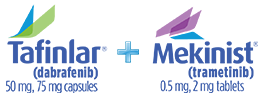
Mechanism of Action
MAPK Pathway
TAFINLAR AND MEKINIST TARGET 2 DISTINCT POINTS ON THE MAPK PATHWAY*,†
Studied extensively as monotherapies and in combination1,2
TAFINLAR inhibits cell growth of various BRAF V600E mutation–positive tumors in vitro and in vivo
Inhibiting MEK1 and MEK2 with MEKINIST can suppress downstream signaling of the MAPK pathway
Alterations in the MAPK pathway can inhibit normal, nontumor cells and result in side effects, some of which may be serious
Combination therapy with TAFINLAR + MEKINIST resulted in greater and more prolonged inhibition of tumor growth compared with either drug alone in BRAF V600E–mutant tumors in vitro and in vivo1,2
In vitro and in vivo findings may not translate to clinical significance as combination therapy.
ERK, extracellular signal-related kinase; MAPK, mitogen-activated protein kinase; MEK, mitogen-activated extracellular signal-regulated kinase; RAF, rapidly accelerated fibrosarcoma; RAS, monomeric G protein.
*BRAF V600E can result in constitutive activation of kinases that may stimulate tumor cell growth in the BRAF pathway. Trametinib and dabrafenib target 2 different kinases in the RAS/RAF/MEK/ERK pathway. Dabrafenib is an inhibitor of some mutated forms of BRAF kinases, including BRAF V600E. Trametinib is a reversible inhibitor of MEK1 and MEK2.1,2
†Shown in in vitro and in vivo studies.1,2

